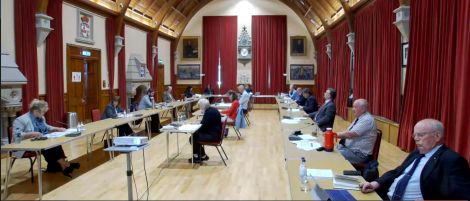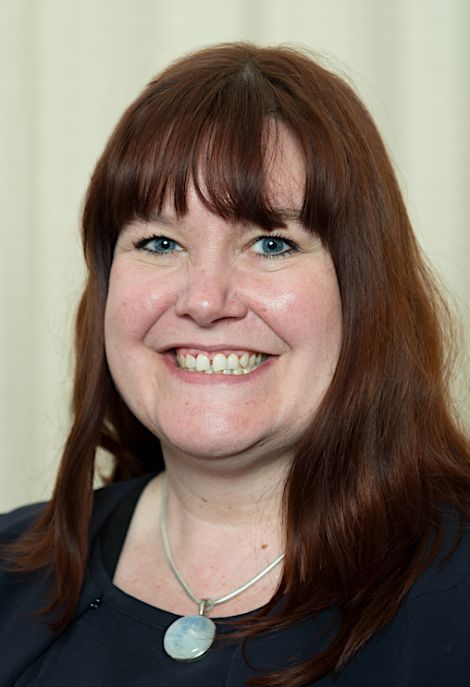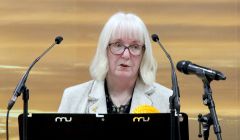Council / Opportunity for SIC to ‘build back better’ as isles move out of lockdown, councillors hear
SHETLAND Islands Council (SIC) has approved a recovery and renewal framework which the local authority will use as the isles move out of lockdown.
Elected members gave the document their approval at a meeting of the full council on Thursday.
There was a feeling in the socially-distanced Lerwick Town Hall that the pandemic has created an opportunity to “build back better” as services return to a ‘new normal’.
Improved digital connectivity and cutting carbon emissions are among the potential opportunities the SIC could capitalise on, councillors heard.
A report to members, meanwhile, showed that the SIC has incurred £2.4 million in extra costs so far in its response to Covid-19.
Councillors also heard that the cost of implementing a blended learning approach to education in Shetland’s schools would amount to nearly £8 million.
However, the Scottish Government now intends to have pupils in class full-time instead, with the blended learning plan reserved as a contingency.
SIC chief executive Maggie Sandison updated councillors on the response to coronavirus, with elected members quick to praise council staff’s work during the pandemic.
The framework details how the recovery and renewal phase will look, with a number of work strands featured.
The first piece of work will be a community impact assessment, which will explore issues like the health and psychological effects, impact on business and disruption to services.
There is also a focus on ensuring Shetland’s needs are taken into account in national planning, and understanding the experiences of other Scottish local authorities.
The renew phase will focus more on public services resuming, and how this may look – with working from home, distancing and cleaning all on the agenda as life continues in the ‘new normal’.
There is also an emphasis on economic and third sector recovery, and community sustainability – such as supporting the vulnerable and safeguarding wellbeing.
Become a member of Shetland News
“The purpose of the framework is to ensure a co-ordinated approach is taken to our work, to maximise the impact that our collective resources can have on the future of Shetland,” SIC chief executive Maggie Sandison wrote in her report to councillors.
“Given the severity of the economic and social harms of lockdown, it is therefore imperative that a co-ordinated strategic approach is taken to managing Shetland’s recovery from the incident,” she said.
“The global scale of the impacts of the virus and the response means that this is not simply about returning to how things were before February 2020, but is instead an opportunity to address weaknesses that existed in our economic and social system prior to the pandemic, including tackling inequalities, inclusive growth and delivering a low carbon future.”
The aims of the Shetland’s Partnership Plan – a 10-year document which brought together agencies like the SIC, NHS Shetland, Police Scotland and Highlands and Islands Enterprise – will be used as the “foundation” of recovery and renewal activity.
The plan’s vision is that “Shetland is a place where everyone is able to thrive; living well in strong, resilient communities; and where people and communities are able to plan and deliver solutions to future challenges”.
However, “the place we have started from has changed”, Sandison said.
A key early piece of work will be a community impact assessment – with a warning made that some of the effects of the pandemic will last for up to two decades.
“It is necessary to understand the physical, psychological, economic and community impacts of the virus and the response,” Sandison wrote.
“The council and its partners must be in a position to provide statutory services and work together to address any gaps in service provision, which are necessary to prevent and mitigate harm, strengthen our community and improve the wellbeing of our people.
“It is recognised that the impact assessment will need to be a process that continues for a long period as the health, economic and social harms will be felt for 15-20 years. There will be a need to regularly revisit and reassess the impacts and imagine medium and long-term scenarios for how the impacts will need to be mitigated.”
Sandison’s report also described the impact on the local economy over the last four months as a “seismic shock”.
Creating new private sector jobs – a long-held ambition of development officials – will be “particularly difficult but even more critical than before”.
A number of proposed projects have been pinpointed as sources of job creation, which could assist the recovery and renewal phase, from the interconnector and the energy hub project to Shetland Space Centre.
As previously reported, development committee chairman Alastair Cooper warned that there could be a sharp rise in unemployment over the next two years.
Sandison said it is also important that projects need to be ready to apply for possible government funding.
Her report continued to say that “people are at the heart of our community so they must also be at the heart of our renewal”.
“The physical, mental and social wellbeing of individuals and the community has been detrimentally impacted by lockdown,” she said.
“The pandemic and the response to manage transmission has widened inequalities and created further disadvantage, poverty and hardship.
“A local employability partnership has been developed to coordinate resources in the recovery/renewal phases around employability support, skills development and to understand what gaps there may be in current service provision to respond to the needs of individuals and families in our changing economy.”
There have been a “great community strength and resilience” shown in Shetland, according to Sandison,
“In a world with greater demand for support and less public sector funding, the capacity for communities and individuals to use their assets for problem solving and meeting their wellbeing requirements rather than seek solutions from the public sector will be essential,” her report added.
“The long-term impacts on public sector funding will create a drive for public sector reform to resize and reshape the public sector to deal with an increased demand for services with fewer resources.”
Speaking to councillors, Sandison said: “We have been asked to plan for 18 months to two years’ disruption.”
A number of questions and comments of debate were raised by councillors as the item spanned two hours, including from Lerwick North member John Fraser who said there should be a “tangible” recognition for the work of council staff during the pandemic.
Fellow town councillor Stephen Leask also questioned about the prospects of a localised approach to future lockdowns or restrictions in case of another outbreak.
SIC leader Steven Coutts said the priority during the pandemic has been on protecting the vulnerable, but there will be a “whole new raft of vulnerabilities in the future”.
SNP councillor Robbie McGregor, meanwhile, called on councillors to put any of their possible political allegiances aside when it comes to Shetland’s response to Covid-19.
He called on the other members, who were all voted in as independent members, “not to play to the gallery and make cheap political points”.
“Let’s present a united front to try to get the best outcome for Shetland,” the SNP man said.
A fire alarm went off in the Town Hall as McGregor concluded his address – with members having to leave the room before soon returning.
South mainland member George Smith said everyone needs to be this together – “from a community level right through to government level”, while southend councillor Allison Duncan said the lack of certainty on how the Covid-19 situation in Shetland will develop is a major issue.
“The problem is that we don’t know where our enemy is going to strike next,” Duncan said.
Become a member of Shetland News
Shetland News is asking its readers to consider paying for membership to get additional perks:
- Removal of third-party ads;
- Bookmark posts to read later;
- Exclusive curated weekly newsletter;
- Hide membership messages;
- Comments open for discussion.
If you appreciate what we do and feel strongly about impartial local journalism, then please become a member of Shetland News by either making a single payment, or setting up a monthly, quarterly or yearly subscription.



















































































